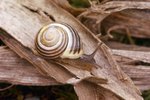
According to the University of California Museum of Paleontology, more than 15,000 species of nematodes are currently known. Commonly referred to as roundworms, these creatures can range in size from about 3/4 of an inch to nearly 30 feet in length. Despite the diversity found in this phylum's inhabitants, they all share some characteristics, including a primitive body cavity, a simple digestive system, and a flexible external covering.
Primitive Body Cavity
Roundworms are classified as pseudocoeloms, because they do not have a full-fledged body cavity. The body cavities found in more advanced non-nematode species are lined with mesodermal tissue, as are the organs. In pseudocoeloms, however, the cavity is lined with mesodermal tissue on the outside but endodermal tissue internally. Endodermal tissue develops into the digestive tract, while mesodermal tissue can become a number of different body components, including bones, skin, and the liver.
Shape and Body Structure
Nematodes are often confused with flatworms because of similarities in physical appearance. However, nematodes have thread-like, cylindrical bodies, and the name of the worm derives from the Greek word for thread. Their bodies are also non-segmented, unlike earthworms. Nematodes are bilaterally symmetrical, meaning both halves of their bodies are identical.
Simple Digestive System
Although nematodes lack a well-defined head, they do have a mouth at one end of their bodies. The roundworm uses the 16 organs in its mouth to bring food into its digestive system. From the mouth, the food goes into the pharynx where it is crushed by muscles. The food then goes into the gut for digestion. The nutrients move to the cells and the waste moves out of the body, thanks to the two excretory canals located on either side of the nematode's body. The waste eventually leaves the worm's body through its anus located at the opposite end of the cylindrical body.
Protective Cuticle
Nematodes do have a layer of skin -- the epidermis -- that covers their bodies. Unlike human skin which is made up of cells, the roundworm's epidermis is made up of collections of undifferentiated cellular material. This skin layer releases the cuticle that forms a coating over the skin, providing additional protection for the body while remaining flexible enough to allow for the worm's side-to-side movements. The cuticle is not what prevents nematodes from crawling or lifting themselves up. Instead, a roundworm's movement is limited because the muscles below the skin are positioned longitudinally, preventing anything but side-to-side movement.
Parasitism & Crytobiosis
While all roundworms share similar bodies, they can be divided in one way: some are free-living, while others are parasites. The former have much simpler life cycles than the latter, but the parasitic roundworms are the ones of most concern to humans because they can cause serious illness. Parasitic nematodes include hookworms, pinworms, and worms that cause trichinosis, elephantiasis, and river blindness. Many parasitic roundworms and even some other nematodes are capable of cryptobiosis. Cryptobiosis allows the nematode to go into a state of extreme hibernation in which it is essentially dead but can come back to life when the environment is more favorable. Using this ability, roundworms can survive in many extreme environments.
References
- University of California Museum of Paleontology: Introduction to the Nematoda
- Animal Diversity Web: Nematoda
- East Stroudsburg University: Phylum Nematoda
- The University of Edinburugh: Phylum Nematoda
- Penn State University: Unique Features to Nematoda
- National Center for Biotechnoloy Information: Endoderm
- Princeton University: Mesoderm
Photo Credits
-
Duncan Smith/Stockbyte/Getty Images
Writer Bio
Amy Jorgensen has ghostwritten more than 100 articles and books on raising and training animals. She is also an amateur dog trainer. She has also written more than 200 blog posts, articles, and ebooks on wedding and party planning on behalf of professionals in the field.




